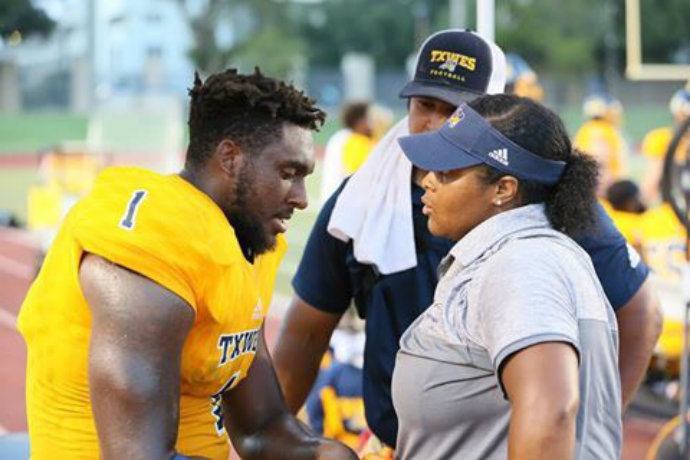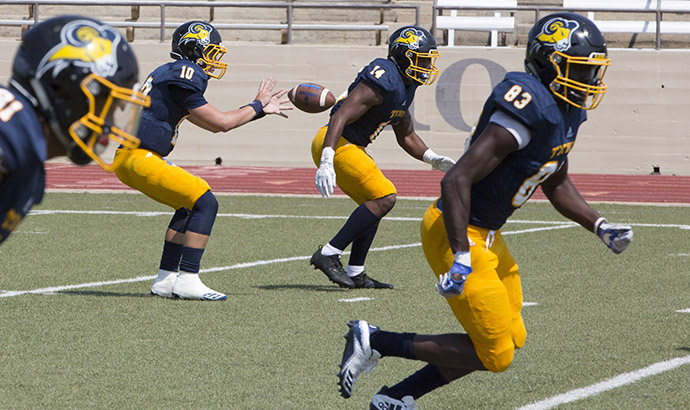TXWES Athletic Trainer: A day in the life of Dominique Brown

Athletic trainers are a critical component of collegiate sports. These highly-trained professionals work hard to help athletes reduce on-the-field risks and prevent injuries, and are prepared to administer emergency care. We sat down with Texas Wesleyan Athletic Trainer Dominique Brown to learn more about her role and the skills it takes to be a TXWES Athletic Trainer.
Why did you decide to pursue athletic training as a career?
I chose Athletic Training because I’ve always been passionate about helping people, and I participated in athletics growing up. Another factor was my interest in physical education and medicine. I essentially fused my loves of sports and medicine together—it’s the best of both worlds as I serve my athletes. And what better view than from the sideline!
Take us through a normal day as an AT. When do you wake up? Are there specific things you do as you start the day, as well as throughout the day?
Well, if there’s anything I can say about the normal day in the life of an ATC is that it’s always changing! I typically wake up between 4:30 a.m. and 5 a.m. Monday – Friday. When I arrive at the athletic training facility (ATF), I begin morning treatment hours which typically begin at 7 a.m. Treatments Hours include the use of modalities, stretching, manual therapy and physical therapy as a preventative and/or rehabilitative measure. During this time, my athletic training students learn and assist me with the care of athletes. I also work on administrative duties and a couple days during the week, I attend the football coaching staff meeting to debrief the staff on the injury report.
Football practices begin around 2 p.m. My students and I arrive at the stadium at least an hour and a half prior to practice to set up the sideline with our equipment, which includes water coolers, ice chests, hydration station, tent, sideline table, emergency equipment, etc. When the athletes arrive, my students and I begin taping and wrapping for practice. During practice, I observe the athletes for any potential situations that could cause an injury or medical condition as well as provide hydration. After practice, my students and I break down the field, provide ice to athletes and clean and store all equipment. Finally, I drive back to campus and stay in the ATF for about 30 minutes, just in case an athlete needs anything that he did not or could not receive at the field. Then, I’m done for the day!
What are the most important things you stress to TXWES students who are learning about Athletic Training from you?
Top 5 Most Important Things:
- Have CONFIDENCE in your skills!
- Continued education is vital in the Athletic Training profession—Invest in yourself, learn new things, ask questions
- You have to be passionate about Athletic Training
- Documentation: Athletic Training students need to know that documentation is vital in any health allied profession. Specifically related to Athletic Trainers, documenting injuries, therapy and/or treatments provided, insurance claim forms, and other administrative documentation.
- Take time to care for yourself! You cannot and will not be able to provide care to your patients/athletes if you are not 100 percent yourself.
Athletic trainers play such a critical role in the safety of our athletes. What are some of the top things you and your staff are safeguarding against? How critical is it that ATs are prepared for emergency situations?
Concussion Management is definitely a medical condition that Athletic Trainers safeguard against. With concussions, there is also the risk of Second Impact Syndrome. Concussion Management has been in the mainstream of Athletic Training and sports for the past several years. Understanding how to properly educate, prevent, assess, and treat concussions is important. The best way to achieve optimal outcomes with athletes is through an extensive Concussion Protocol. Here at TXWES, we are intentional about making sure that our protocol will provide the best possible outcomes for our student-athletes suffering from a concussion injury.
Because we’re in Texas, another major thing we safeguard against is Exertional Heat Illnesses—specifically, heat stroke. I can’t stress enough the importance of Certified Athletic Trainers (ATs) being present at all athletic events. We’re trained to recognize these medical emergencies when others may not. Heat stroke is a medical emergency and is the most severe form of heat illnesses. We recently activated our EAP for a football student-athlete who was suffering from heat stroke. And as a result, the athlete was properly treated in a timely manner, which led to an optimal outcome, and that’s the most important thing!
The best way to prevent this medical emergency is through education. Athletes have to know that proper hydration before, during, and after activities is very important, along with pre-participation examinations, proper nutrition, and acclimation to heat. Again, I am grateful myself and my team were available to do our job well, and the athlete benefitted from our knowledge and experience. This is why we are here…to take care of athletes!







